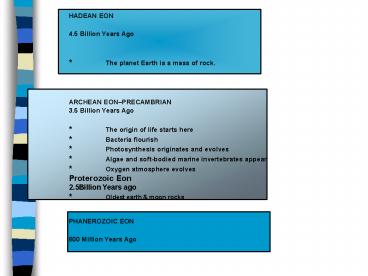HADEAN EON - PowerPoint PPT Presentation
1 / 12
Title:
HADEAN EON
Description:
The Old Stone Age. 10,000 8,000 BC ... The New Stone Age. 8,000 3,000 BC *Global population is estimated to be less than 200 million ... The Iron Age. 2,000 BC AD 250 ... – PowerPoint PPT presentation
Number of Views:14013
Avg rating:3.0/5.0
Title: HADEAN EON
1
HADEAN EON 4.5 Billion Years Ago The
planet Earth is a mass of rock. ARCHEAN
EONPRECAMBRIAN 3.5 Billion Years Ago The
origin of life starts here Bacteria flourish
Photosynthesis originates and evolves Algae
and soft-bodied marine invertebrates appear
Oxygen atmosphere evolves Proterozoic
Eon 2.5Billion Years ago Oldest earth moon
rocks PHANEROZOIC EON 600 Million Years Ago
2
Paleozoic Era Cambrian Period 590505 Million
Years Ago Diverse algae Origin of most marine
invertebrate types Ordovician Period
505438 Million Years Ago Invertebrates
dominate the sea First jaw less fishes and
fungi MASS EXTINCTION AT THE END OF THIS
PERIOD
3
Silurian Period 438408 Million Years
Ago Diversification of jawless fishes First
bony fishes Colonization of land by plants and
animals. The first type of green algae to come
out of the sea is called
charophyte. Seedless vascular plants, the
first psilophytes, including ferns and
horsetails, appear. Devonian Period 408360
Million Years Ago Diversification of fishes
First insects and amphibians The origin of
the seed psilopsids, lycopsids, sphenopsids and
some ferns and gymnosperms
are present Plant embryos can now leave the
parent plant
4
- Carboniferous Period
- 2 more divions Mississipian (360-315)
Pennsylvanian (315-286) - 360286 Million Years Ago
- Extensive forests
- First reptiles
- Insects radiate
- Psilopsids are no longer present
- Three types of lycopsids, three types
of sphenopsids, - two types of ferns and
- three types of gymnosperms are
present - Permian Period
- 286248 Million Years Ago
- Continents aggregate into Pangaea
- Reptiles radiate
- Amphibians decline
- Many types of insects
- Two types of lycopsids, three types of
sphenopsids, three types of ferns,
5
Mesozoic Era Triassic Period 248213 Million
Years Ago Continents begin to drift Early
dinosaurs appear First mammals appear
Diversification of marine invertebrates One
type of bryophyte, two types of lycopsids, one
type of sphenopsid, two
types of ferns and six types of gymnosperms are
present MASS EXTINCTION AT THE END OF THIS
PERIOD Pangaea First Stage of Continental
Drift Diagram.
6
Jurassic Period 213144 Million Years
Ago Continents drifting Diverse dinosaurs
First birds The first angiosperms appear.
Flowers evolve creating a specialized
reproductive structure that produces
seeds enclosed within an ovary. One type of
bryophytes, one type of lycopsid, one type of
sphenopsid, two types of
ferns and five types of gymnosperms are present
7
Cretaceous Period 14465 Million Years
Ago Most continents widely separated
Continued dinosaur radiation Flowering
plants and mammals diversify Angiosperms
radiate and diversify One type of bryophytes,
one type of lycopsid, one type of sphenopsid,
two types of ferns and four
types of gymnosperms are present MASS
EXTINCTION AT THE END OF THIS PERIOD
8
Cenozoic Era Tertiary Period 65 Million Years
Ago This period can be divided into the
following Epochs Paleocene Epoch (6554
Million Years Ago) Eocene Epoch (5437 Million
Years Ago) Oligocene Epoch (3724 Million Years
Ago) Miocene Epoch (245 Million Years
Ago) Pliocene Epoch (52 Million Years
Ago) Continents nearing current position
Radiation of birds, mammals, flowering plants
and pollinating insects Three types of
gymnosperms are present Angiosperms dominate
the landscape Mild climate at the beginning of
this period Extensive mountain building and
cooling toward the end of this period
9
Quaternary Period 2 Million Years
AgoPresent Pleistocene Epoch (20.01 Million
Years Ago) Recent (0.01 Million Years
Agopresent) Repeated glaciation in the
Northern Hemisphere People evolve
Extinction of larger mammals A mixture of
gymnosperms and angiosperms are present
Currently we are in the Recent Epoch, in the
Quaternary Period in the CENOZOIC ERA. During
this Epoch, the following Ages have been
documented
10
The Old Stone Age 10,0008,000 BC Population
of the earth is estimated to have been
approximately less than 100 million The New
Stone Age 8,0003,000 BC Global population
is estimated to be less than 200 million The
Bronze Age 3,0002,000 BC Global population
is thought to have remained the same
(approximately 200 million)
11
The Iron Age 2,000 BCAD 250 Global population
is thought to have remained the same
(approximately 200 million) The Middle Ages
AD 2501200 Global population rises to 250
million AD 1400 Population drops to 75
million following the Bubonic Plague (Black
Death) AD 1800 The Industrial Revolution
begins.
12
(No Transcript)































